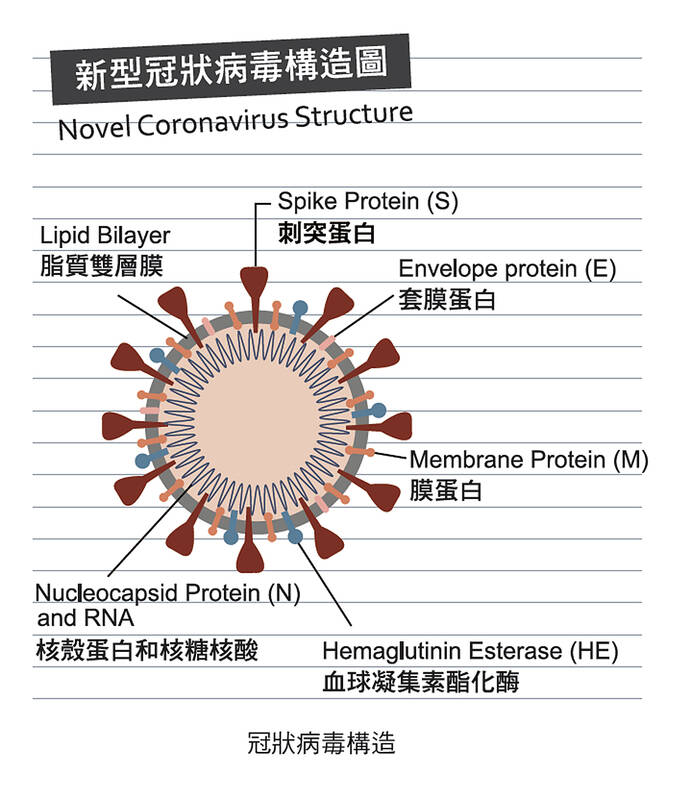COVID-19 簡介:
嚴重特殊傳染性肺炎 (COVID-19) 疫情爆發以來,冠狀病毒 (coronavirus) 成為熱門討論話題。我們利用這機會來了解病毒(virus) 的定義,以及它與細菌 (bacterium) 之間的不同。
和多數為單細胞生物的細菌不一樣,病毒甚至連細胞都不是,是由蛋白質 (protein) 形成的外殼包裹的一段 DNA 或 RNA,是一種類生物,介於生命體及非生命體之間。病毒無法獨立生長,但能感染大部分具細胞結構的生命體,它存活的方式是藉由感染宿主的細胞,再利用它們來自我複製。其形態有螺旋形、二十面體、包膜型等等。冠狀病毒就是因外表有許多突起,看起來像皇冠而得名。

Photo/Graphic courtesy of Bookman l 圖片:書林
病毒顆粒只有約細菌的百分之一。細菌等病原體無法通過尚柏朗過濾器 (Chamberland filter),但病毒卻可以。因此,1899年,荷蘭微生物學家貝傑林克(Beijerinck) 將這類物質命名為濾過性病毒 (filterable virus)。Merriam-Webster 對 virus 的定義是:
any of a large group of submicroscopic infectious agents (超顯微傳染媒介物) that are usually regarded as nonliving extremely complex molecules (複分子), that typically contain a protein coat (蛋白質外殼) surrounding an RNA or DNA core of genetic material but no semipermeable membrane (無半透膜), that are capable of growth and multiplication only in living cells, and that cause various important diseases in humans, animals, and plants
病毒學 (virology),是微生物學 (microbiology) 底下的一個分支,迄今人類已鑑定出超過 6000 種病毒。病毒的傳播方式非常多樣,流感 (flu) 病毒可以經由咳嗽和打噴嚏傳播;諾羅病毒 (Norovirus) 可以通過手、食物和水來傳播;愛滋病毒 (HIV) 則可以通過體液接觸傳播;登革熱 (Dengue fever) 通過蚊蟲叮咬傳播。攜帶病毒的生物載體,如蚊子,稱為 vector (病媒),非生物載體如:水、空氣,稱為vehicle。在通常情況下,病毒感染會引發免疫反應來消滅入侵的病毒。而免疫反應可透過注射疫苗來產生,使接種者能夠對相應的病毒免疫。

Photo/GRAPHIC courtesy of Bookman l 圖片:書林
抗生素對病毒沒作用,但有些抗病毒藥物已經研發出來,例如克流感 (Tamiflu) 就是針對流感病毒的藥物。除了 COVID-19以外,2003年爆發的 SARS(嚴重急性呼吸道症候群)、2012 至 2015 年在中東和南韓曾流行過的 MERS(中東呼吸症候群)都屬於冠狀病毒。其共同的特點是引起人類和其他脊椎動物的呼吸道疾病。
冠狀病毒讓人生畏的其中一點,便是會引起「人畜共通」的傳染病,因為宿主多元,難以防治,又容易突變。
2019 年底爆發的嚴重特殊傳染性肺炎,因為爆發地為中國武漢,一開始國內外媒體多以武漢肺炎 (Wuhan pneumonia) 稱之,其後,世界衛生組織將病毒名為 2019-nCoV,稱為 2019-nCoV 急性呼吸疾病 (2019-nCoV Acute Respiratory Disease)。
台灣官方將此疾病命名為「嚴重特殊傳染性肺炎」;中國媒體則在 2020年 2 月將其命名為「新型冠狀病毒肺炎」,簡稱新冠肺炎。
其實,英語裡的 pneumonia(肺炎)是指呼吸道感染引起肺部發炎,算是嚴重的疾病。然而不論是SARS,還是 COVID-19,其引起的症狀不一定嚴重到肺炎的程度。但在華語圈,往往把輕重不同的呼吸道症狀都稱為「肺炎」,準確的說法應稱為「疾病」 (disease)。因此「新型冠狀病毒病」才是 COVID-19 最恰當的名稱。世衛組織於2020年2 月 11 日宣布,為避免污名化特定地區 (to avoid references to a specific geographical location, … aimed at preventing stigmatization),正式將此疾病命名為COVID-19,並說明 CO 代表冠狀 (Corona),VI 代表病毒 (virus),D 代表疾病 (disease)。
註:新冠病毒病目前正式的英文名稱是 COVID-19,英美媒體則往往只把第一個字母大寫,拼成 Covid-19。像 Covid 這樣的縮寫 (abbreviation),如果把它當一個字來唸,如:/?kouv?d/,英文叫 acronym,如果是字母一個一個分別唸,譬如 FBI,英文叫 initialism。
文章由書林出版公司提供:
www.bookman.com.tw
蘇正隆 — 台灣翻譯學學會前理事長、師大翻譯研究所兼任副教授; 編著《英語的對與錯》,《世紀病毒:必讀防疫英文知識與詞彙》...等

A: What’s the theme of the 2025 Taiwan Lantern Festival’s main lantern? B: The theme is “Paradise,” and the main lantern is a snake-shaped “infinity” symbol that features a lighting show every half an hour. A: Cool, I heard that there are over 300 lanterns. B: There are even giant lanterns in the shape of Pikachu and some other popular Pokemon characters. A: Let’s go now. A: 2025台灣燈會主燈的主題是什麼? B: 主題是「無限樂園」!主燈的造型則是蛇形的數學「無限號」,主燈每半小時還有一次燈光秀。 A: 酷喔,聽說總共有300多件花燈作品。 B: 甚至還有皮卡丘和其他熱門寶可夢角色的巨型花燈呢。 A: 哇我們現在就出發吧! (By Eddy Chang, Taipei Times/台北時報張聖恩)

本文由生成式AI協作,本刊編輯編修。 Tucked away in southwestern Taiwan, Yunlin County is a treasure trove of cultural heritage, rich history, and natural beauty. From its stunning temples and glove puppetry to historical architecture and picturesque landscapes, Yunlin rewards those who venture off the beaten path. Yunlin is renowned for its flourishing temple culture. Temples in this region are not merely places of worship but also communal centers where people gather for festivals, rituals, and social functions. One of the most notable temples here is the Beigang Chaotian Temple, which was built more than 300 years ago and is dedicated to Matsu, the sea

After steel and aluminum, US President Donald Trump has set his sights on slapping 25 percent tariffs on semiconductors, cars and pharmaceuticals. Trump has already slapped additional 10 percent tariffs on goods from China and has also threatened tariffs on Canada and Mexico, plus ordered a study into putting into place reciprocal tariffs. Here’s a look who would be hit the hardest if US import tariffs on semiconductors, cars and pharmaceuticals go into force. SEMICONDUCTORS: ASIA IN THE CROSSHAIRS Semiconductors, or microchips, are the brains in our electronic devices and demand has soared with the development of AI, which

Nestled within the heart of Taipei, National Taiwan University (NTU) contains a grand and spacious sanctuary where nature and academia come together in perfect accord. Across its expansive 111-hectare campus, NTU reveals a landscape rich with history, lush greenery, and a thoughtfully preserved ecosystem. This tranquil haven invites visitors to take their time wandering among the elegant buildings, to admire the rare plants, and to experience a space that exudes quiet inspiration. Zhoushan Road: A Gentle Prelude to NTU’s Tranquility Beginning at Gongguan MRT Station, the enchanting avenue Zhoushan Road leads visitors into NTU shaded by golden rain trees, cottonwoods, and Javanese